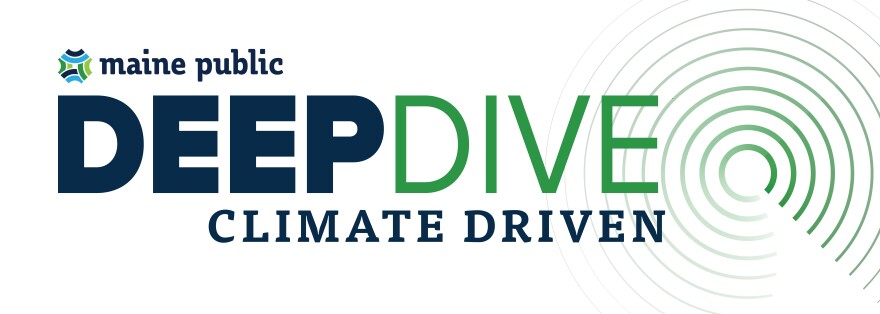The cows at Wolfe’s Neck Center are eating their breakfast in the dairy barn. They chomp on strands of hay, which were baled late last summer to sustain them all winter long.
"You can kind of smell that kind of fresh, almost kind of like fermented smell," said Tom Prohl, Wolfe's Neck Farm Operations Manager. "And that's all the nutrients wafting up for these cows to enjoy. And you see they're loving it.”
Prohl said this year, Wolfe’s Neck Center is focused on transitioning the cows to an entirely grass-fed diet, eliminating grain. Nearby, Dairy Manager Ben Gotschall uses a pitchfork to disperse the hay among the cows.
“We are trying to move more towards a grass-fed operation to eliminate the need for mechanically harvested grains that are often imported at great distances with the use of fuels," Gotschall said.
This story is part of our series "Climate Driven: A deep dive into Maine's response, one county at a time."

“This is just their winter breakfast. In the growing season once things dry out, they go right out in the pasture and start eating grass," Prohl said.
And when the cows eat that grass, it’s more than just mealtime. It’s part of Wolfe’s Neck regenerative agriculture practice, which they define as an approach to farming that “builds healthy soils, reduces air pollution, conserves water, and increases biodiversity.”
“It's our duty to steward this land responsibly. And make sure that year to year this land is getting better, our ecosystem is getting cleaner and stronger and more resilient," Prohl said.
Increasing food system resiliency in the face of climate change is the foundation of the work being funded by a $35 million grant from the U.S. Department of Agriculture's Partnerships for Climate Smart Commodities program. The award was announced last September.
Through its global collaborative called OpenTEAM, Wolfe's Neck Center and its partners will develop agricultural technologies, collect data on carbon storage in soil, and share best practices for improving soil quality. Money will also be passed through to farmers when they adopt certain practices that have climate benefits.
Wolfe's Neck Executive Director Dave Herring said the goal is to launch around 500 pilot projects with farms across the country, with a focus on supporting dairy in the Northeast, rice in California and grain in Colorado and the mountain west.
“We like to talk about the future of agriculture being less input intensive, and being much more knowledge intensive," Herring said. "Instead of increasing the inputs that we're putting into our farm system, like more fertilizer, and more pesticides, we're really trying to gain more knowledge from the farming that we're doing.”
Wolfe’s Neck Center’s project is one of 141 projects nationwide, funded by more than $3 billion in grants. The national project hopes to reach 60,000 farms over more than 25 million acres of working land, which could have a significant impact on agricultural systems that account for 10% of the total greenhouse gas emissions in the United States, and about a quarter of global emissions.
“We want to see a new normal for what we expect from agriculture," said Dorn Cox, Wolfe's Neck Center's research director.
Cox also leads OpenTEAM and is overseeing the USDA grant. The program’s foundational goal is to increase carbon storage in the soil.
In fact, Cox said, there is an opportunity in agriculture not just to become carbon neutral, but to capture more carbon in the soil than is emitted by farming.
“Agriculture is what makes the difference between achieving our goals and not achieving our goals," Cox said. "So we can do a lot with reducing carbon emissions through solar and transportation and electrification and so forth. But agriculture is what puts us over the edge.”
Wolfe’s Neck Center will also be engaged with its partners in developing stronger markets for climate-friendly products.
Britt Lundgren is the Director of Sustainability and Government Affairs for Stonyfield Farms, which purchases raw milk directly from Wolfe’s Neck.
“We know that more and more people are aware of the impact that agriculture has on climate change. And when they're shopping in the grocery store, they're looking to buy food that supports their values," Lundgren said.
And Lundgren said consumers should be given enough information so they can be sure that what they're buying is truly organic.
“There are more and more companies that are trying to claim that they're taking action on climate," Lundgren said. "And we all need to put data behind those claims, or they're meaningless, right? And so OpenTEAM enables companies to put that data behind their claims if their supply chains engage with farmers that are using OpenTEAM.”
Wolfe's Neck Center's Tom Prohl agrees, and said its important to protect terms such as "regenerative" from being falsely applied to food products.
"Us farmers and folks in the food system... we're really working hard to make sure that the word regenerative doesn't get greenwashed and turn into something that's just slapped on a label here, there and everywhere," Prohl said. "So we're really hoping that as the regenerative movement gains more traction, that we can get some metrics and understanding behind it so that it's not something that gets thrown around and loses value.”
Wolfe’s Neck expects to have initial data about carbon storage in soil after the first three to five years of the project.







